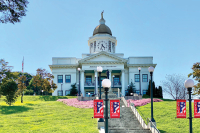New park visitor center to showcase stored artifacts
A design has been finalized for a new $3 million visitor center at the North Carolina entrance to the Great Smoky Mountains National Park outside Cherokee.
The new visitor center will focus on the cultural history of the park, from early Native Americans to Appalachian heritage. The park has thousands of artifacts collected from people who once lived in the park, but they are locked up in storage since the park has nowhere to display them. The new visitor center will finally put the public in touch with some of these implements of early life, from spinning wheels to farm tools to moonshine stills.
“We are going to be using those artifacts to tell the story of the people who lived here,” said Kent Cave, a park ranger who supervises visitor outreach with a specialty in Appalachian studies. “This is a fulfillment of a dream and of a promise.”
Cave said the original plan for the park dating back to the 1940s called for a cultural heritage museum on the N.C. side of the park, while the visitor center on the TN side focuses on ecology and natural history of the Smokies.
The cultural heritage theme will dovetail with the Mountain Farm Museum already in place at Occonaluftee, where visitors can see old farm buildings and demonstrations of early life.
“You aren’t just talking about the stuff, you are out there with it,” said Bob Miller, spokesperson for the park. “You can feed the chickens and talk to people about what they are seeing. This will be an extension of the farm.”
Related Items
Miller said the park will judiciously select which artifacts go on display, since the park has far more than the new visitor center can possibly hold.
“A tiny portion of this stuff will be on display, just like at the Smithsonian where only a tiny portion of what they have is displayed for the public,” Miller said.
The current visitor center at Occonaluftee is old, cramped and doesn’t do justice to the most visited national park in the country.
Nearly 2 million people crossed into the park via the entrance on U.S. 441 last year, passing by the doorstep of the visitor center. Only 350,000 people ventured inside, but far more might stop in if it offered more in the way of exhibits.
The old visitors center was constructed in the 1930s by the Civilian Conservation Corp with the intention of serving merely as a ranger station. It is only 1,100 square feet, while the new one will be almost 7,000.
The old visitor will be converted to classroom space. The new visitor center will be constructed beside it. The parking lot will be reconfigured, along with the entrance off U.S. 441.
“We are extremely excited about having a new state-of-the-art facility,” said Park Superintendent Dale Ditmanson.
Ditmanson lauded the fundraising that will pay for the entire cost of the new center.
The Great Smoky Mountains Association, which operates bookstores in the park, has committed $2.5 million for its construction. The Friends of the Smokies will provide the $500,000 to design and create all the maps, exhibits and displays.
The visitor center will meet national certification standards as an environmentally friendly building under LEED (Leadership in Energy and Environmental Design).
“The new Center is being designed be as energy efficient and sustainable as we can make it,” Ditmanson said.
Some of the environmental designs being considered are
• Geothermal Heat and Cooling: The heating and cooling system will take advantage of the constant 55 degrees temperature of the earth, by pumping water into the ground though tubing where it will gain or give off heat, increasing the efficiency of the system.
• Passive solar: The orientation of the building and the select placement of windows will allow plenty of sunshine into the building and also provide heat. Working with the Oak Ridge National Laboratory, the Park has taken solar measurements where windows are to be placed, to be sure they are sized correctly, to allow just the right amount of light, and offset the need for heat.
• Rain water cistern: A cistern will be collect rain water from the roofs. The water will be filtered and then used to flush toilets.
• Water Saving Fixtures: Bathroom fixtures will use waterless urinals and water saving water faucets and toilets.
• Recycled Materials: Everything from roofing materials, to cabinets, siding, and structural supports will be made of recycled materials.
• Landscaping: Natives plantings will be used that will not require extensive watering after they become established.









